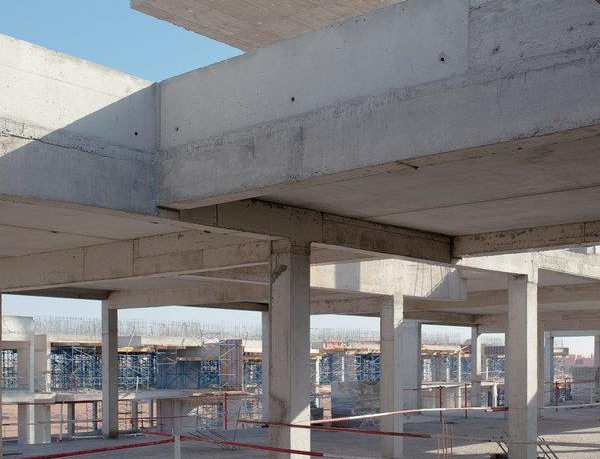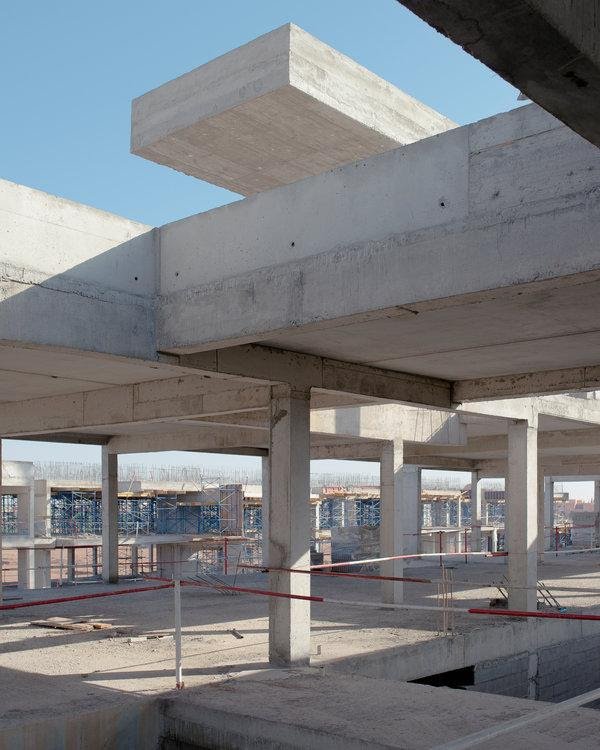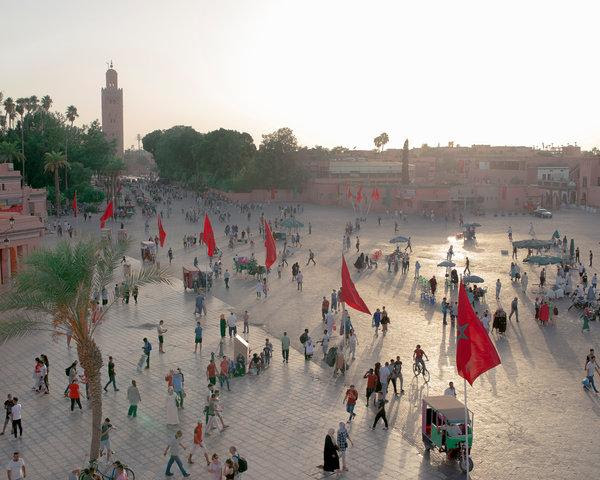NY Times
Elliott Verdier for The New York Times
As more wealthy tourists flock to Morocco, Marrakesh is reinventing itself with luxury hotels and resorts to attract its share.
Construction on M Avenue, a $100 million multi-use project in Marrakesh, Morocco. A surge of wealthy international visitors is helping charge the high-end construction boom in the city.
One of the first stops for visitors to this city is the medina, the cacophonous mazelike Arab quarter of the city, bustling with snake charmers, henna artists and shopkeepers selling spices, pottery and textiles.
Lately, Marrakesh is also abuzz with more modern sounds: the hum of construction vehicles building a flurry of luxury hotels and resorts to accommodate a growing wave of tourists.
Marrakesh has long been a weekend getaway for well-heeled Moroccans from Casablanca and Rabat, the nation’s capital. But a surge of wealthy international visitors is helping charge the high-end construction boom and bringing global attention to the “Red City,” as it is named because of its rose-colored buildings.
In early August, the singer Madonna celebrated her 60th birthday in Marrakesh and documented the festivities on Twitter.
Jemaa el-Fnaa square in the medina, the cacophonous mazelike Arab quarter of Marrakesh. Elliott Verdier for The New York Times
More than 11 million people visited Morocco in 2017, an increase of 10 percent over the previous year, according to the Moroccan Ministry of Tourism. The number of American visitors has increased at an even quicker pace. Last year, more than 254,000 Americans visited the North African country, a rise of 29 percent over 2016 and 81 percent over 2012.
More flights, an easing of visa regulations and a concerted effort by the Kingdom of Morocco to modernize infrastructure and improve safety have all played a part. As more visitors come to Morocco, Marrakesh is reinventing itself to lure its share of tourists, who stay an average of three nights.
“One of the main challenges of the tourism sector in Marrakesh is increasing the length of stay,” said Alexis Reynaud, an editorial manager at the Oxford Business Group, a research and consulting firm. “New high-end resorts and hotels are starting to offer much more than just luxury lodging to encourage people to stay longer.”
Leading the pack among these new ventures is M Avenue, a $100 million multiuse project known as Garden Avenue because it will include nearly 108,000 square feet of gardens and landscaped areas alongside about 183,000 square feet of shops, restaurants, cafes and galleries. Lodging will include a 168-room hotel from the Portuguese hotelier Pestana and 88 private residences from the Four Seasons.
A rendering of the Four Seasons private residences in the M Avenue development.Downtown Hotel Corporation
A rendering of M Avenue’s Pestana CR7 hotel, a joint venture between Portugal’s largest hotel chain and Cristiano Ronaldo, the soccer star. Downtown Hotel Corporation
“We are trying to create a new city center,” said Nabil Slitine, the chief executive of M Avenue Development, who in 2011 helped open the Four Seasons Resort, one of the first international hotels in the city.
Paul White, president of residential for Four Seasons Hotels and Resorts, said he wanted to increase the company’s footprint in Marrakesh. M Avenue, which is near the airport and the Palais de Congrès conference center, offers “access to the sights of the city, including the medina and Menara gardens, while also acting as a convenient takeoff point to venture into the surrounding region, including the Atlas Mountains,” he said.
Nearby, a W hotel is under construction, a Ritz-Carlton hotel is slated to open in 2022, and a Park Hyatt hotel is being built amid a $450 million urban golf and retail complex known as Marrakech Golf City, set to open in 2024.
Even as demand has increased, several obstacles have stymied these projects. Instability in other North African countries such as Egypt and Tunisia caused concern for early investors, and the scarcity of usable land in Marrakesh makes large real estate projects expensive.
Much of Marrakesh is already developed, and other areas are suited only for agriculture because of existing irrigation systems. To further complicate matters for developers, once the owner of a plot of land dies, it is divided among surviving members of the family.
“If you want to buy a big parcel of land, then you need to speak to many stakeholders, and convincing them all to sell their land can be a headache,” Mr. Reynaud said.
The Four Seasons Resort is one of the first international hotels in Marrakesh.Elliott Verdier for The New York Times
In the case of M Avenue, half the site was vacant and the other half was occupied by an agricultural administration and research center. It took four years to reach an agreement with the Moroccan government and construct a building for the employees elsewhere in the city, Mr. Slitine said.
But now, with 65 percent of its buildings up, M Avenue is on schedule to open in late 2019.
The government has made a big push to promote the country and Marrakesh in particular. A new police division focused on tourism has helped decrease theft, violence and drug trafficking to make the city safer for tourists.
The government has also modernized infrastructure, including the construction of a new central train station in 2008. In late 2016, a new terminal was added to the international airport in Marrakesh.
Business visitors are also coming in larger numbers, thanks to more international conferences such as the 22nd session of the Conference of the Parties, or COP22, a climate change meeting in 2016.
The easing of visa regulations for specific countries has also bolstered tourism. In June 2016, Morocco exempted Chinese nationals from visa requirements. In 2017, 118,000 visitors came from China, a 1,022 percent increase from 2015.
To take advantage, Marrakesh is ramping up its offerings. Visitors already flock to the city to explore the many secret gardens, to unwind in the traditional Moroccan steam baths called hammams and to wander the souks. These marketplaces, full of shops lining alleys and narrow streets, sell a wide variety of products, like ornate Berber carpets, hand-painted tagines, and dates, nuts and other fruits.
Marrakesh is also fashioning itself as a contemporary art destination. The French fashion designer Yves Saint Laurent famously started spending time in Marrakesh in the 1960s, and in late 2017, an Yves Saint Laurent museum opened near one of the designer’s former residences near the Majorelle Garden. Designed by the French painter Jacques Majorelle, the 2.5 acres of gardens contain hundreds of species of plants, landscaped streams and pools, and bright cobalt blue buildings, making it one of Marrakesh’s biggest tourist draws.
“High-end museums and art help attract wealthier travelers,” Mr. Reynaud of the Oxford Business Group said. “Tourists can visit galleries and also buy art at reasonable prices compared to London, New York and Paris.”
Drawing more attention from the international art world, the Museum of African Contemporary Art Al Maaden, the first nonprofit museum of its kind in Africa, reopened in February in conjunction with the 1-54 Contemporary African Art Fair, a show in London, New York and now Marrakesh.
M Avenue will also amp up the city’s cultural offerings with various new galleries, showcasing up-and-coming artists from Morocco and abroad. Also planned is M Bab, a 32,000-square-foot immersive multimedia cultural center and theater. It will be run by the French company Cultival, which creates programs for the Eiffel Tower and Paris’s opera house.
M Avenue’s planned Pestana CR7 hotel will bring a Portuguese influence, too. This joint venture between Portugal’s largest hotel chain and Cristiano Ronaldo, the soccer star, will target millennials. Mr. Ronaldo said he was drawn to Marrakesh for his latest CR7 hotel (named after his jersey number) because it was a “unique destination, exotic and authentic, with enormous tourism potential.”
With 65 percent of its buildings up, M Avenue is on schedule to open in late 2019.Elliott Verdier for The New York Times
Although 80 percent of the Four Seasons residences are sold, it remains to be seen how the broader real estate market in Marrakesh absorbs all the properties under construction.
In 2017, overall real estate prices in Marrakesh rose 5 percent, but the volume of trades fell 13 percent. “Prices were too high — the bubble had to burst. Now, it’s a better window to buy, ” Mr. Reynaud said.
“In any case, Marrakesh is dramatically different than even five years ago,” he said. “It’s no longer just a backpacker destination.”









